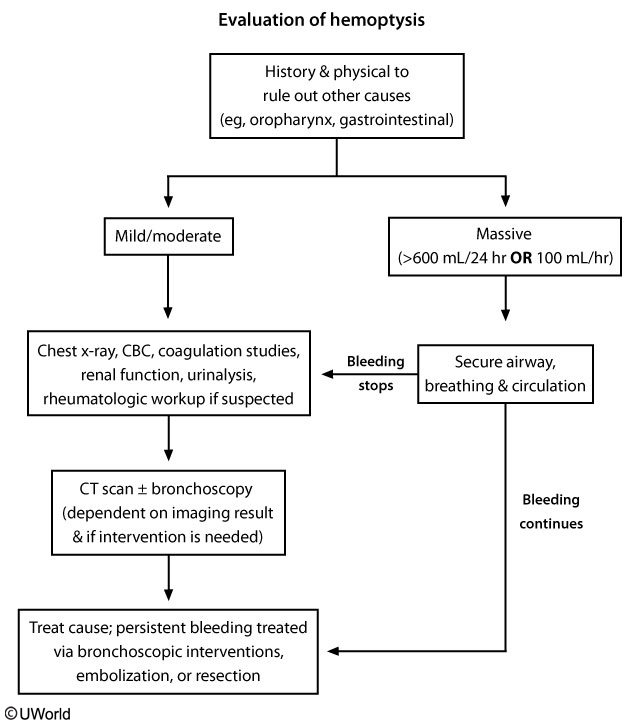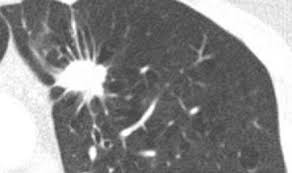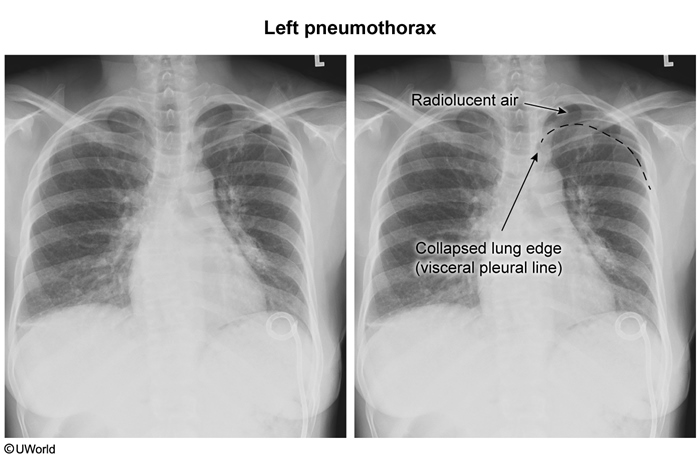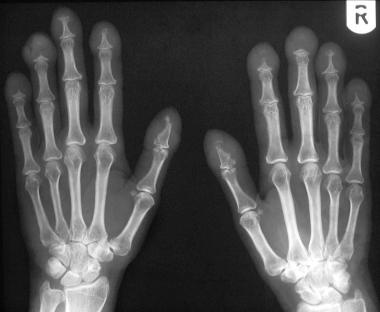21 Pulmonary
Hemoptysis


massive bleeding: This patient has an episode of massive hemoptysis, defined as >600 mL of expectorated blood over a 24-hour period or a bleeding rate >100 mL/hour. The greatest danger in massive hemoptysis is not exsanguination but asphyxiation due to the airway flooding with blood. Initial management involves establishing an adequate patent airway, maintaining adequate ventilation and gas exchange, and ensuring hemodynamic stability. The patient should be placed with the bleeding lung in the dependent position (lateral position) to avoid blood collection in the airways of the opposite lung.
Bronchoscopy is the initial procedure of choice in such patients as it can localize the bleeding site, provide suctioning ability to improve visualization, and include other therapeutic interventions (eg, balloon tamponade, electrocautery).
Urgent thoracotomy and surgical intervention are reserved for patients with unilateral bleeding who continue to bleed despite initial bronchoscopy and/or pulmonary artery embolization.
ARDS
Acute respiratory distress syndrome (ARDS) is an acute lung injury due to an inciting event causing complement activation and subsequent lung damage, leading to refractory hypoxemia.
Remember causes of ARDS with the mnemonic ARDS (AAAARDDDSSS):
Aspiration
Acute pancreatitis
Air or Amniotic embolism
Radiation
Drug overdose
DIC
Drowning
Shock
Sepsis
Smoke inhalation
Symptoms of ARDS include:
acute dyspnea
cyanosis
tachypnea
wheezing
rales and rhonchi
Lab findings consistent with ARDS include:
respiratory alkalosis
decreased O2
decreased CO2
A Swan-Ganz catheter will show a wedge pressure less than 18 mmHg. This is key difference between ARDS and cardiogenic pulmonary edema which has a PCWP greater than18 mmHg.
It is very difficult to oxygenate someone with ARDS: the PaO2/FIO2 ratio is < 200.
A CXR will show bilateral pulmonary edema and infiltrates.
Mechanical ventilation with PEEP is often required for treatment of ARDS.
Fluid volumes should be kept low to prevent pulmonary edema.
Atelectasis
Atelectasis is the decrease in lung volume secondary to partial collapse of lung tissue. Atelectasis is usually secondary to:
Operations (decreased lung compliance)
Impaired inspiratory ability (may be from pain)
Lack of a cough reflex
Obstructions such as tumors
Foreign bodies (especially in children)
Resorption (occlusion) atelectasis occurs when an airway is obstructed by a foreign object, tumor, or thick mucus plug and the alveoli collapse. This can be identified on physical exam by an area devoid of lung sounds.
Compression atelectasis occurs when a space occupying lesion in the pleural cavity (most likely air or fluid) increases pressure on the small airways leading to alveolar collapse.
Patients with atelectasis typically present with:
Dyspnea
Fever (classically post-op day 1)
Pleuritic chest pain
Tachycardia
Hypoxia
May be asymptomatic if small or chronic
Physical exam demonstrates:
Dullness to percussion
Decreased breath sounds
Crackles on auscultation (if airway is patent)
Chest X-ray findings vary depending on the location:
Raised diaphragm in lower lobe atelectasis (particularly the left hemidiaphragm)
Tracheal deviation towards the atelectasis in the upper lobes
Fluffy infiltrates
The treatment of atelectasis includes:
Incentive spirometry
Deep breathing
Ambulation
Potentially bronchoscopy to investigate a cause of an obstruction if there is no resolution of symptoms with less invasive measures
Complications of atelectasis include:
Damage to the lung parenchyma
Pneumonia
Respiratory failure
Solitary Pulmonary Nodules
A solitary pulmonary nodule is a radiological finding of a well demarcated opacity less than 3 cm in size on chest x-ray (CXR) or computed tomography (CT) that presents without associated pleural effusion, adenopathy, or atelectasis.
CXR is strongly suggestive of a benign processes if the nodule demonstrates:
Size < 2 cm
Diffuse, popcorn, or concentric calcifications
Clearly demarcated edges
A solitary pulmonary nodule has a higher probability of malignancy if it demonstrates:
Size > 2 cm
Asymmetric calcification
Spiculation or corona radiata:

The most common causes of benign solitary pulmonary nodules are infectious granulomas and hamartomas.
The most common causes of malignant SPN are:
Primary lung cancer
Metastasis
Carcinoid tumor
Once a solitary pulmonary nodule has been identified on CXR, the first step is to compare previous x-rays or scans.
Patients who have a stable nodule based on previous imaging for 2-3 years require no further testing and can be offered reassurance that they most likely do not have cancer.
If the patient has no previous films or the nodule appears suspicious the next best step is CT imaging.
Once a CT has been obtained in a patient with a new nodule or a patient has changes in nodule based on previous x-ray the next step is to evaluate overall risk of malignancy based on:
Radiographic appearance of the lesion
Age of the patient
Risk factors for cancer (eg. tobacco use, family history)
Recommended follow up for a solitary pulmonary nodule with a low probability of malignancy is serial chest CT scans. The follow-up timing of these scans is dependent on the individual characteristics of the nodule.
If the solitary pulmonary nodule has an intermediate probability of malignancy and is > 0.8 cm (8 mm) patients require positron emission tomography (PET) scan. If the PET scan is suspicious for malignancy, a biopsy should be done.
Patients with an intermediate probability of malignancy who have a lesion < 0.8 cm (8 mm) should have serial CT scans.
Biopsy and surgical removal of solitary pulmonary nodules by video assisted thoracoscopic surgery (VATS) is indicated for lesions with a high probability of malignancy and for nodules with intermediate risk that demonstrate malignant features on histology or PET scan.
Pneumothorax

visceral pleural lines:

Hemothorax
A hemothorax is a collection of blood in the pleural space, and can be caused by:
Trauma
Aortic dissection
Tuberculosis
Malignancy
Signs and symptoms of a hemothorax include:
Dyspnea
Pleuritic chest pain
Dullness to percussion
Decreased breath sounds
Decreased tactile fremitus
Hemothorax is best diagnosed with upright chest x-ray which will show blunting of the costophrenic angles with as little as 300 ml of fluid in the chest wall.
The first concern in any patient who presents with hemothorax are the ABCs (airway, breathing and circulation). Following ABCs, treatment involves tube thoracostomy (chest tube).
Immediate drainage of more than 1.5L of blood from a chest tube in a patient with hemothorax is considered a massive hemothorax. Patients with massive hemothorax are treated with emergent surgical thoracotomy.
Incomplete or inefficient drainage of hemothorax can result in a retained hemothorax as retained blood provides a nidus for infection. Patients with retained hemothorax usually present several days to a week after chest tube removal with:
Low grade fever
Dyspnea
Chest pain
Patients with retained hemothorax require surgical draining with video-assisted thoracoscopic surgery (VATS) to remove the clotted blood and fibrinous peel.
Lung Cancer Overview
There are many different forms of lung cancer, which occur with the following frequency:
Adenocarcinoma, 25-35%
Squamous cell carcinoma, 25%
Small cell carcinoma, 15%
Large cell carcinoma, 5%
Metastatic lung disease, 10%
Other 5-10%
Risk factors include:
Smoking accounts for 85% of cases → linear relationship between pack-years and risk of lung cancer.
Products of combustion, such as second-hand smoke or car exhaust
Asbestos
Radon
Overall, carcinoma of the lung is the #1 cancer killer of both men and women today.
Patients present with general symptoms of pulmonary disease, such as:
Cough
Dyspnea
Wheezing
Hemoptysis
Fatigue
Weight loss
Paraneoplastic syndromes
Bronchial obstruction caused by malignancy can increase the risk of pneumonia and can prevent the body's natural ability to clear infection within the lung parenchyma. Recurrent pneumonia in the same anatomic location is a red flag for lung cancer.
The first step in working up a patient with suspected lung cancer is CT scan of the chest.
A definitive diagnosis requires a tissue sample, usually obtained via endobronchial ultrasound (EBUS)-directed biopsy (central tumors). In cancers that cannot be accessed by EBUS (peripheral tumors), biopsy can be obtained by video-assisted thoracic surgery (VATS).
Complications
Complications include mass effects, paraneoplastic syndromes, pleural effusion, and metastatic disease.
Specific mass effects include:
Superior vena cava syndrome: Obstruction of the superior vena cava by a mediastinal tumor or metastatic lesion → "facial fullness," venous dilation and edema of the head, neck, and arms, including JVD. Most common with small cell lung cancer.
Horner's syndrome: Invasion of cervical sympathetic chain by apical tumor → unilateral facial anhidrosis, ptosis, and miosis.
Pancoast's tumor: Superior sulcus tumor affecting C8-T2 nerve roots → shoulder pain radiating down the arm, arm weakness. Commonly occurs with Horner's syndrome.
Lung cancer most commonly metastasizes to:
Brain
Bone
Adrenal glands
Liver
Mnemonic: Bad Breath Attacks the Liver
Treatment
Treatment for lung cancer is based on the type of lung cancer and staging of the disease (e.g. local extension, lymph node involvement, and presence of metastases [TNM]) and includes:
Surgical excision (lobectomy, video-assisted thorascopic surgery [VATS])
Chemotherapy
Radiation
Surgical resection is only indicated if predicted postoperative FEV1 is at least 800 mL.
Small-cell lung cancers are usually non-operable and are treated with chemotherapy and radiation.
Lung cancer has a very poor prognosis, with a 5 year survival rate of only 10%.
If lung cancer is metastatic, it may be treated with chemotherapy and/or radiation. Surgery is only used to treat symptoms in metastatic lung cancer.
Small Cell
Small cell lung cancer, like squamous cell lung cancer, more commonly arises centrally near the hilum or major bronchi.
Small cell carcinoma is associated with many paraneoplastic syndromes:
Cushing syndrome (ectopic ACTH secretion)
SIADH
Ectopic growth hormone secretion
Peripheral neuropathy
Subacute cerebellar degeneration
Lambert-Eaton syndrome
Limbic encephalitis
Dermatomyositis
Because small cell lung carcinomas are highly mitotic and undifferentiated, they are very sensitive to radiation and chemotherapy treatments. Surgery is generally not effective.
Large Cancer
Large cell lung cancer usually arises peripherally.
Paraneoplastic syndromes associated with large cell lung cancer include gynecomastia and galactorrhea.
Large cell lung cancer responds poorly to chemotherapy, so it should be removed surgically when possible.
Squamous
Squamous cell carcinoma of the lung is more common in males, arises centrally, and is strongly associated with smoking.
Squamous cell carcinoma often appear as cavitating lesions on CXR.
Paraneoplastic syndromes associated with squamous cell carcinoma include:
Hypercalcemia, from secretion of PTHRP (parathyroid hormone related peptide)
Dermatomyositis
Treatment for squamous cell carcinoma includes surgery, chemotherapy, and radiation.
Adeno
Lung adenocarcinoma is the "oddball" lung cancer: It is more common in women than in men and is not strongly associated with smoking. It also arises more commonly in the periphery of the lung as opposed to central locations seen in squamous and small cell lung carcinomas.
Lung adenocarcinoma is associated with the following paraneoplastic syndromes:
Hypertrophic osteoarthropathy (a specific form of clubbing)
DIC
Thrombophlebitis
Microangiopathic hemolytic anemia
Dermatomyositis

Adenocarcinoma of the lung is treated with surgery, chemotherapy, and radiation.
Pleural Effusion
A pleural effusion is a collection of fluid between the parietal and visceral pleura.
Increased vessel permeability, secondary to inflammation, causes exudative effusions. Etiologies include:
Lung infections (e.g. pneumonia)
Tuberculosis
Cancers (e.g. lung, breast, lymphoma, mesothelioma)
Pulmonary embolism
Impaired pleural lymphatic drainage
Increased hydrostatic pressure or decreased serum oncotic pressure causes transudative effusions. Etiologies include:
Hydrostatic pressure changes (e.g. CHF)
Oncotic pressure changes (e.g. nephrosis, cirrhosis)
Injuries to the pleural lining (e.g. central venous catheter misplacement)
Pulmonary embolism can uniquely cause either transudative or exudative effusions.
chylous
Damage to the thoracic duct preventing normal draining of lymphatic fluid causes chylous effusions, which typically have a turbid, milky appearance. Etiologies include:
Iatrogenic (most commonly surgery)
Traumatic
Malignant: Lung carcinoma, breast carcinoma, and lymphoma are the three tumors that cause approximately 75% of all malignant pleural effusions.
Symptoms of a pleural effusion include:
Dyspnea
Pleuritic chest pain
Associated findings, such as night sweats (TB), weight loss (cancer), swelling (nephrosis)
Worsening symptoms with time
Physical exam for pleural effusion may demonstrate:
Decreased breath sounds to auscultation
Dullness to percussion
Decreased fremitus
Pleural rub
Tracheal deviation, if large
Chest x-ray classically shows blunting of the costophrenic angles. Fluid may be loculated or free flowing and changes location depending on the position of the patient (e.g. supine patients have fluid collections posteriorly).
Lateral decubitus chest x-rays are the most sensitive chest x-ray view.
On chest x-ray, transudative effusions tend to be bilateral, whereas exudative effusions tend to be unilateral.
Thoracentesis is used to determine whether the pleural fluid is transudative or exudative using Light’s criteria. At least 1 of the following suggests an exudative effusion:
Pleural protein/serum protein ratio greater than 0.5
Pleural LDH/serum LDH ratio greater than 0.6
Pleural LDH greater than ⅔ of the upper limit of normal serum LDH levels
Treatment strategies for exudative and transudative effusions are aimed at treating the underlying cause.
Treatment of parapneumonic effusions (effusions around a pneumonia):
Antibiotics for uncomplicated effusions
Chest tube drainage for complicated effusions (e.g. frank pus during thoracentesis)
Pneumonia
Pneumonia may be community-acquired or healthcare acquired (dialysis unit, nursing home, hospital).
Community-acquired pneumonia develops outside the hospital or within 48 hours of admission.
Healthcare acquired pneumonia develops greater than 48 hours after admission. Often acquired from ventilators. Note: Healthcare acquired pneumonia may also develop up to 90 days after hospital stay of at least 2 nights, or up to 30 days after a stay in a nursing home or rehab facility.
Aspiration
Aspiration is a common cause of pneumonia with gram negative organisms and anaerobes.
Aspiration pneumonia typically occurs in the right lower lobe.
Risk factors for aspiration pneumonia include:
Reduced consciousness (e.g. seizures, alcoholism)
Oropharyngeal muscle fatigue (e.g. myasthenic syndromes, muscular dystrophy)
GERD
Poor dentition
Procedures (e.g. bronchoscopy, upper endoscopy, nasogastric feeding)
The drug of choice for patients with suspected aspiration pneumonia is clindamycin due to its coverage of anaerobic bacteria.
Chest radiographs are useful in diagnosing CAP. Radiographic findings on chest x-ray for typical pneumonia are:
Interstitial infiltrates
Lobar consolidation
Cavitation
Other tests for diagnosis of CAP include: sputum sample and gram stain and culture.
Management
To determine whether a patient is to be hospitalized for pneumonia, the CURB-65 criteria is commonly used, which includes:
C: confusion
U: blood urea nitrogen > 19mg/dL
R: respiratory rate > 30min
B: blood pressure systolic < 90, diastolic < 60
65: Age > 65
Patients with scores of 2 or more should be admitted, while those with scores less than 2 can be treated as outpatients.
Outpatient treatment in previously healthy patients with no use of antimicrobials for three months is azithromycin or doxycycline.
The outpatient treatment in patients with comorbidities such as chronic heart, lung, liver, or renal disease; diabetes mellitus; alcoholism or antibiotic therapy in the past 3 months is:
Respiratory fluoroquinolone (moxifloxacin, gemifloxacin, or levofloxacin).
OR
β-lactam (first-line agents: high-dose amoxicillin, amoxicillin-clavulanate; alternative agents: ceftriaxone, cefpodoxime, or cefuroxime) PLUS a macrolide (azithromycin, clarithromycin, or erythromycin).
Inpatient treatment of pneumonia patients not in the ICU and outpatient treatment in patients with comorbidities such as chronic organ disease or immunosuppressive conditions or medications involves:
Respiratory fluoroquinolone (moxifloxacin, gemifloxacin, or levofloxacin).
OR
Antipneumococcal β-lactam (cefotaxime, ceftriaxone, or ampicillin-sulbactam) PLUS a macrolide (azithromycin, clarithromycin, or erythromycin).
Inpatient treatment of pneumonia in patients in the ICU:
Antipneumococcal β-lactam (cefotaxime, ceftriaxone, or ampicillin-sulbactam) PLUS either azithromycin OR respiratory fluoroquinolone (moxifloxacin, gemifloxacin, or levofloxacin).
OR
Aztreonam and a respiratory fluoroquinolone in penicillin-allergic patients.
PE
A pulmonary embolism is the blockage of the pulmonary vessels by either:
Air
Thrombus
Fat
Pulmonary thromboemboli typically form as clots in the venous system and most commonly arise in:
Iliac veins
Popliteal veins
Femoral veins
Calf veins rarely cause emboli.
Risk factors for developing a pulmonary thromboembolism include:
Obesity
Smoking cigarettes
Virchow's triad (venous stasis, endothelial damage, hypercoagulability)
Estrogen
Fractures (especially causing fat embolism)
Pregnancy
Immobilization
Post-operative (classically day 5)
Underlying malignancy
Pulmonary thromboemboli commonly result from one of the components of Virchow's Triad:
Venous stasis
Hypercoagulability
Endothelial damage
Venous stasis predisposes to pulmonary thromboemboli because decreased blood flow velocity allows for coagulation, commonly occurring in hospitalized or immobile patients.
Hypercoagulability, a predisposing factor for pulmonary thromboemboli, can occur congenitally (e.g. factor V Leiden, protein C deficiency) or by acquired conditions (e.g. antiphospholipid syndrome, pregnancy, post-operative states).
Endothelial damage predisposes to pulmonary thromboemboli by exposing the subendothelial collagen to platelets, causing the coagulation cascade and leading to clot formation.
Patients with a pulmonary thromboembolism typically present with:
Acute onset
Shortness of breath
Tachypnea
Pleuritic chest pain
Leg swelling
Wheezing
Hemoptysis
May be asymptomatic
May cause sudden death (e.g. saddle emboli)
The probability of a pulmonary thromboemboli may be determined by the Modified Wells Score:
Clinical symptoms of deep vein thrombosis (3 points)
Other diagnoses are less likely than pulmonary embolism (3 points)
Heart rate greater than 100 (1.5 points)
Immobilization three or more days or surgery in previous four weeks (1.5 points)
Previous deep venous thrombosis or pulmonary embolism (1.5 points)
Hemoptysis (1 point)
Malignancy (1 point)
A score less than or equal to 4 means a PTE is unlikely.
The gold standard for diagnosing a pulmonary thromboembolism is CT pulmonary angiogram with IV contrast (spiral CT), which will characteristically show a wedge infarction.
Contraindications for a CT pulmonary angiogram include:
Renal insufficiency
Contrast allergy
Pregnancy (V/Q scanning is diagnostic modality of choice)
On electrocardiography, pulmonary thromboemboli cause sinus tachycardia and non-specific ST and T wave changes:
T-wave inversion in the anterior leads
S1Q3T3 (a large S wave in lead 1 and a Q wave and an inverted T wave in lead III)
On echocardiography, pulmonary thromboemboli may present with increased right ventricular size with decreased right ventricular function (due to RV overload) and pulmonary hypertension.
The D-dimer test and the PERC criteria are helpful when evaluating a patient for an unlikely pulmonary thromboembolism:
Normal D-dimer values indicate an embolism probably isn't present
High D-dimer values indicate an embolism may be present
Note: It is unnecessary to memorize the individual PERC criteria for the purposes of Step 2.
Patients with a pulmonary thromboembolism typically have the following laboratory findings:
Respiratory alkalosis
Hypoxemia
Increased A-a gradient
Elevated D-dimer
On chest x-ray, patients with pulmonary thromboemboli may show:
No abnormal findings (most common)
Hampton's hump (wedge shaped area of infarcted tissue)
Westermark sign (oligemia)
Pleural effusions
Ventilation and perfusion scans (V/Q scans) show decreased perfusion with normal ventilation and are used when contrast is contraindicated (e.g. renal injury, pregnancy).
Patients with a thromboembolism are managed with:
Supportive therapy (e.g. resuscitation, vasopressors, supplemental oxygen)
Anticoagulation with warfarin for at least 3 months and bridging with heparin until warfarin is therapeutic.
After three months, in patients with an unprovoked PE (i.e. no surgery, immobilization, trauma) or in patients with two or more PEs, the risks and benefits of indefinite anticoagulant therapy should be assessed.
Patients with severe pulmonary thromboemboli (e.g. saddle emboli) are managed with:
Anticoagulation
Fibrinolytics
Embolectomy
Patients with a pulmonary thromboembolism in which anticoagulation is contraindicated (e.g. post-operative patient, previous intracranial hemorrhage, high fall risk) receive an inferior vena cava filter.
Complications of a pulmonary thromboembolism include:
Hemorrhagic infarction of the lung (most likely at the lung bases)
Exudative or transudative pleural effusions
Cardiac failure from a saddle embolus
Last updated
Was this helpful?